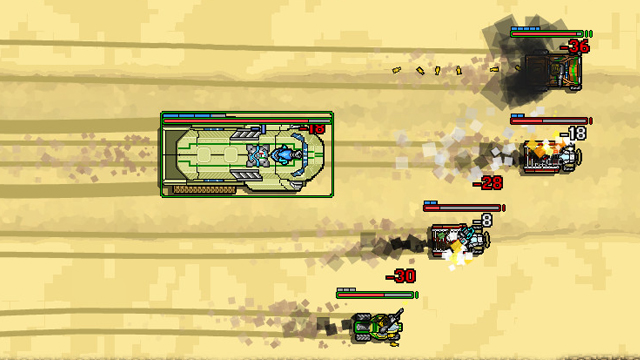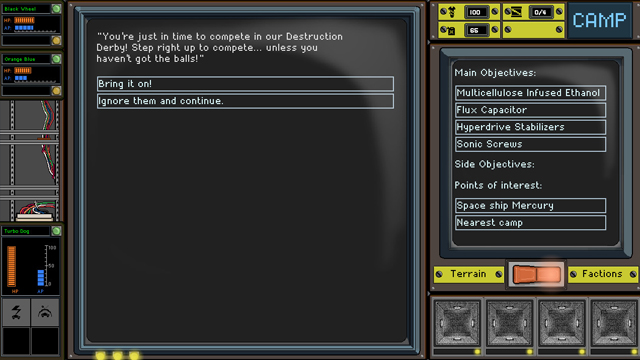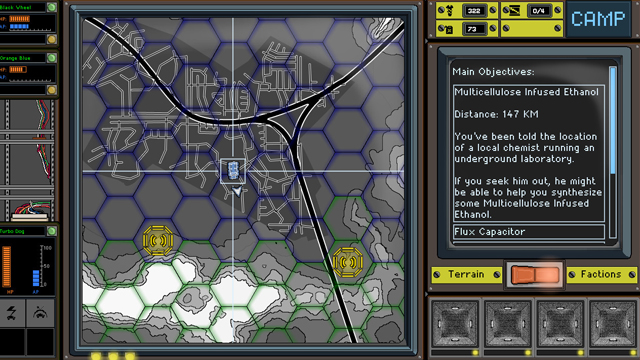
Convoy Games originally pitched Convoy as FTL: Faster Than Light crossed with Mad Max, and it wasn’t messing around. You have a difficult mission to complete. You buy upgrades for your vehicles using bolts gained from combat and side quests. Every time I lost, I felt like it was my own fault. So there’s FTL covered; it’s hard but fair, and every time I lose I want to come back for more. On the Mad Max side of things is the game’s aesthetic and core conceit. Your space ship, the Mercury, has crash landed on a dangerous planet. Luckily for you, the MCV (a giant hauler and your core vehicle) and a couple of smaller vehicles are still operational. It’s up to you to navigate the map, collect vital components and escape.
After the short tutorial, you’ll start the game proper and have no real idea what to do. Clicking on one of the needed components will give you an objective arrow. You can make a beeline for the objective or stick to the roads. Either way, I wish that movement was handled hex-to-hex with an indicator of how much fuel the movement will take. This would make it easier to keep your convoy on the road to save fuel.

When you encounter enemies, the view shifts away from an overhead hex map to a zoomed-in view of your MCV and up to four escort vehicles speeding through the landscape. Enemies will attempt to converge on your location from off the screen, and it’s your job as the commander to assign targets and locations to your escort vehicles. Your MCV, despite being a wheeled vehicle capable of cresting mountains and crossing rivers, can’t change its relative position in combat. When enemies lay mines, your choices are to let the MCV take a hit or to move one of your smaller vehicles in front to soak up the damage. It’s a strange disconnect, and even if the MCV is slow, I desperately want the ability to move it out of harm’s way.
The MCV isn’t toothless, however. In my time trying to fix the Mercury, I’ve seen the ability to deploy mines, launch drones and fire missiles. My smaller vehicles have been similarly equipped, with shields to soak up damage wholesale before buckling, armor to protect core health and various guns and cannons to tear foes apart.
Vehicle augments, new vehicles to round out your support roster and upgrades for owned vehicles can be purchased and equipped at the Mercury crash site and various camps scattered about the map. You’ll also buy fuel and repair your vehicles at these camps. Repairing is essential as, even with strong vehicles, it is nearly impossible to escape combat unscathed. The AI will target your MCV relentlessly, and when its HP reaches zero the game is over. Like its space-based influence, FTL, resource management is a balancing act. All the fuel in the world won’t matter if your MCV is low on HP and you never bothered to upgrade your vehicles.

Combat is very fun. It’s great to watch encounters play out and order your vehicles to box in an enemy in such a way that he is forced to collide with a giant rock while you concentrate fire on a different car altogether. I did experience a few instances of soft-locking where I would be taken to a blacked out combat screen. I could see all of my vehicles, but I couldn’t issue orders, there were no enemy combatants to fight and I couldn’t get back to the overworld map. Saving and reloading were no help, as loading the game led me back to the same empty combat screen. The occasional bug was worth it, though. There are a ton of well-written side quests to see, a multitude of weapons to buy and the whole thing feels a bit more forgiving than FTL and other roguelikes. I still haven’t managed to beat it, but I’ll definitely keep trying.
Pros: Combat is fun, vehicles are very customizable, lots of things to do before (or during) tackling the main quest
Cons: Traversal is a little too free-form, MCV can’t be repositioned during combat, some soft locks leading to forced abandonment of current run



















